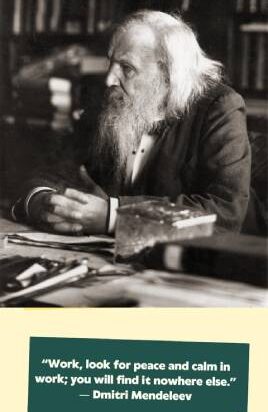Have you ever heard of the periodic table? It’s that big chart full of tiny boxes with letters and numbers. Well, a very smart man named Dmitri Mendeleev helped create it over 150 years ago! His discovery changed the way we understand science forever. Let’s dive into the story of how this genius from Russia made such an important discovery.
Growing Up in Siberia
Dmitri Mendeleev was born in 1834 in a place called Tobolsk, Siberia. Siberia is far from most big cities and is very cold. Dmitri was the youngest of 14 brothers and sisters! His family wasn’t rich, but his mom worked very hard to make sure he could go to school.
When Dmitri’s father got sick and couldn’t work anymore, his mother took over a glass factory to support the family. Unfortunately, the factory burned down, and soon after, both Dmitri’s father and mother passed away. But before she died, Dmitri’s mom made sure he got into a school in St. Petersburg, Russia’s capital.
Dmitri Mendeleev Contribution
In St. Petersburg, Dmitri studied chemistry and fell in love with science. He was curious about how the world worked and wanted to learn as much as he could. One of his teachers, a famous chemist, encouraged him to keep studying. Dmitri did well in school and wrote many papers on chemistry.
But his path wasn’t always smooth. He didn’t always have enough money, and he often got sick. However, Dmitri didn’t give up. He even traveled to different countries, like Germany, to learn more about chemistry.
How Did Dmitri Mendeleev Organize The Periodic Table
In the 1860s, while teaching and writing books, Dmitri started to think about how the chemical elements could be organized. He realized that all elements, like gold, oxygen, and iron, might follow a pattern. But it wasn’t easy to figure out what that pattern was!
One day, while working on his chemistry book, he wrote the names and properties of all the known elements on small cards. He spread them out like a game of solitaire (a card game) and began to notice something special. The elements seemed to fit into groups based on their atomic weights (how heavy they are) and properties (what they can do).
He arranged these cards into rows and columns. Some elements fit together perfectly, like puzzle pieces. Others didn’t fit, so Dmitri made some bold guesses. He even left blank spaces in his table for elements that hadn’t been discovered yet!

Predicting the Future
One of the coolest things about Mendeleev’s table was that he made predictions about elements that didn’t exist yet. He believed that scientists would discover them later. And guess what? He was right!
For example, in 1875, a French scientist discovered a new element called gallium, and it fit exactly where Mendeleev said it would. This made people realize how smart Mendeleev was. Soon after, other elements, like scandium and germanium, were discovered, and they too matched his predictions.
A Few Mistakes Along the Way
Even though Mendeleev was right about many things, he wasn’t perfect. He believed in something called “ether,” which he thought was a super-light element that filled space. But scientists later discovered that ether didn’t exist. Still, his periodic table was such a great idea that his mistakes didn’t matter.
Dmitri Mendeleev Discovery
Mendeleev wasn’t just a chemist. He loved to learn about everything! Studied things like oil, gases, and even cheese-making, and traveled to places like the Baku oil fields to help the country.
He was also a bit of a rebel. In 1890, he quit his job as a professor because he didn’t agree with how the government treated students. Later, he became the head of Russia’s Bureau of Weights and Measures, where he helped standardize how things like length and weight were measured in the country.
Dmitri Mendeleev Family
Dmitri’s personal life was pretty interesting too. Mendeleev was married twice he also had six children. His first marriage wasn’t very happy, but his second wife, Anna, brought him great joy. Even though he wasn’t always neat (he only cut his hair and beard once a year!), people loved him for his brilliant mind.
Did Mendeleev Win a Nobel Prize
In 1905, the Royal Society in London gave Mendeleev a special award called the Copley Medal. This was a big honor! And even though he didn’t win the Nobel Prize, he is still considered one of the greatest scientists ever.
The Man Who played cards with the elements
Dmitri Mendeleev passed away in 1907, but his work lives on. In 1955, a new element was discovered, and scientists named it “mendelevium” in his honor. Today, when you look at a periodic table in your classroom, you can thank Mendeleev for helping us understand how the elements fit together.
He wasn’t just a great scientist; he was a man who never gave up, even when things were tough. His curiosity and determination helped shape modern chemistry, and his periodic table is still used by scientists today.
So, the next time you see a periodic table, remember the story of Dmitri Mendeleev—the man who played cards with the elements and changed science forever!
Which Best Compares And Contrasts How John Newlands And Dmitri Mendeleev Organized Elements
Here’s a chart comparing John Newlands and Dmitri Mendeleev’s contributions to organizing the elements:
| Aspect | John Newlands | Dmitri Mendeleev |
|---|---|---|
| Recognizing Patterns | Developed the “Law of Octaves” and noticed that every eighth element had similar properties, like musical notes. | Noticed patterns and grouped elements with similar properties into columns in his periodic table. |
| Handling Missing Elements | Tried to fit all known elements into his system without leaving gaps for undiscovered elements. | Left gaps in his table for elements that hadn’t been discovered yet and predicted their properties. |
| Accuracy and Acceptance | His “Law of Octaves” worked for some elements but didn’t fit all, leading to less acceptance by scientists. | His table was more accurate, could handle new elements, and gained wide acceptance for its predictive power. |
| Legacy | Provided an early idea about patterns in elements but was less successful in explaining all of them. | Created the periodic table that scientists still use today, with accurate predictions of undiscovered elements. |
Dmitri Mendeleev Quotes
Here are some famous quotes by Dmitri Mendeleev, the creator of the periodic table:
- “There is nothing in this world that I fear to say.”
- “The elements, if arranged according to their atomic weights, exhibit an apparent periodicity of properties.”
- “I saw in a dream a table where all elements fell into place as required. Awakening, I immediately wrote it down on a piece of paper.”
- “Science cannot advance without passionate ambition and clear thinking.”
- “Work, look for peace and calm in work: you will find it nowhere else.”
Dmitri Mendeleev Atomic Model
Dmitri Mendeleev is best known for his creation of the periodic table, but he didn’t propose an atomic model in the way scientists like Dalton, Thomson, or Rutherford did. Instead, Mendeleev’s major contribution was in organizing the known chemical elements based on their atomic weights and properties, which led to the development of the modern periodic table.
Fun Facts About Dmitri Mendeleev
Here are some fun and interesting facts about Dmitri Mendeleev, the brilliant scientist who created the periodic table:
1. The Dream That Changed Science
Mendeleev said that the idea of organizing the periodic table came to him in a dream! He woke up, wrote it down, and that’s how we got the first periodic table.
2. Predicting the Future
Mendeleev left blank spaces in his periodic table for elements that hadn’t been discovered yet. He predicted their properties so accurately that when elements like gallium, scandium, and germanium were found later, they fit perfectly into his table!
3. Not Just a Chemist
Mendeleev invented a type of smokeless gunpowder called “pyrocollodion.” Although the Russian military considered using it, it didn’t catch on.
4. A Man of Many Languages
Mendeleev could speak several languages, including Russian, French, German, and English. This helped him read scientific papers from all over Europe and stay updated with the latest discoveries.
5. Almost a Nobel Prize Winner
Mendeleev was nominated for the Nobel Prize in Chemistry more than once. He came really close in 1906, but due to some politics and disagreements, he never won it.
6. Master of Packing
Mendeleev was so good at packing that his friends joked he could fit an entire room’s worth of stuff into a single suitcase. That’s some serious packing skills!
7. An Element Named After Him
In 1955, scientists named an element after him—Mendelevium (Md), which has the atomic number 101. It was a way to honor his massive contribution to chemistry.
8. The Youngest of 17 Siblings
Mendeleev was the youngest of 17 children, although sadly, many of his siblings didn’t survive infancy.
9. World Traveler
Mendeleev loved traveling and went all over Europe to work with famous scientists like Robert Bunsen and Gustav Kirchhoff. These trips helped shape his ideas and discoveries.
10. Champion for Education
Mendeleev was passionate about education. He believed in modernizing Russian schools and thought science and technology should be a bigger part of learning. He even taught female students at a time when it was uncommon for women to study science.
Dmitri Mendeleev Facts
- Birth Year: 1834
- Birth date: February 8, 1834
- Birth City: Tobolsk
- Birth Country: Russia
- Gender: Male
- Best Known For Russian chemist Dmitri Mendeleyev discovered the periodic law and created the periodic table of elements.
- Industries
- Science and Medicine
- Astrological Sign: Aquarius
- Schools
- University of St. Petersburg
- Main Pedagogical Institute
- University of Heidelberg
- Interesting Facts
- The element mendelevium (Md) was named after Dmitri Mendeleyev in 1955.
- Death Year: 1907
- Death date: February 2, 1907
- Death City: St. Petersburg
- Death Country: Russia

